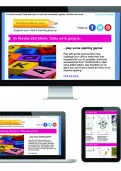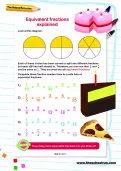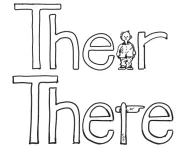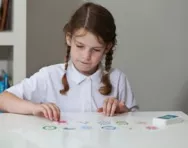What is working memory?

Have you ever noticed that your child can describe what they’ve been doing in Roblox, Minecraft or Fortnite in minute detail, but can’t tell you what they had for lunch at school? Or that when presented with homework, they act as if they’ve never seen such a task before and don’t have the first idea what to do?


Start a unique learning programme!
- Weekly programme for each school year
- Worksheets sent direct to your inbox
- Keeps your child's learning on track
Situations like these can be incredibly frustrating, but your child isn’t just trying to be awkward (honest!). Rather, they’re overloaded with information, and the part of the brain that’s responsible for holding it in short-term memory is overwhelmed. Put simply, their brains just can’t take any more.
Working memory explained
To understand why this happens, we need to understand what working memory is.
‘It’s the part of the brain in which all new learning is processed first,’ explains Steve Garnett, author of Cognitive Load Theory: A Handbook for Teachers (£9.99, Crown House Publishing). ‘Whatever your mind is thinking about or processing right now is all happening in your working memory.’
Working memory can be seen in part as a temporary storage area and processing plant for information that, if the circumstances are right, is then committed to long-term memory.
‘If the information is then frequently thought about, reviewed and recapped, it switches between working memory and long-term memory,’ Steve explains.
When you then need to think about something that’s stored in your long-term memory, it passes back into your working memory, making the information readily accessible.
Why working memory matters for learning
Working memory is important at every stage of education. ‘In a nutshell, all current learning tasks operate in working memory,’ says Steve.
For instance, when your child is learning to spell a new word, such as ‘ambitious’, the letters and their order are held in their working memory.
If they’re to remember how to spell that word in the future, it has to pass from their working memory to their long-term memory. And if, in 12 months’ time, someone asks them how to spell ‘ambitious’, the brain needs to move that information back into their working memory.
Repeating instructions and asking children if they can remember them all will improve their working memory capacity – for example, ‘Hang up your bag, take out your reading book, put it on your table then line up for assembly.’
This process of regular review would also work if, say, trying to recall a new concept such as a cube has 6 faces, 12 edges and 8 vertices.
From working memory to long-term memory
New information doesn’t stay in our working memory. To properly understand it, retain it and be able to recall it in the future, it has to move into our long-term memory.
‘This happens through a process called encoding. Broadly, seeing things, hearing things and making things creates a memory trace that travels into long-term memory,’ Steve explains.
‘This information can be brought back into working memory when the information is frequently thought about, remembered and reviewed. The best way to do this is through lots of reviewing and recall. If you know lots about something – in other words, if you’re more of an expert – it’s because it’s been stored in your long-term memory.’
This is why learning times tables by rote, or drilling spellings every day ready for a test at the end of the week, works: the information is practised lots, reviewed and recalled.
What happens when working memory is overloaded?
The problem with working memory is that it has limited capacity when learning something new. The amount that it can cope with is called ‘cognitive load'.
For example, Steve says, you could talk to someone at length and in detail about your childhood because these experiences have been encoded to your long-term memory.
But if someone talked to you about their childhood and then asked you to repeat as much back to you as possible, you’d struggle, because this new information is only held in your working memory.
‘The problem is that the working memory can’t process very much new stuff at once: roughly seven bits of new information,’ he explains. Most of us – children and adults – have a similar capacity: the ‘magical number seven, plus or minus two.’ It can be even less than this if what you are remembering is more complex, such as a formula.
Some children with special educational needs such as autism or dyslexia have greater problems with working memory, but in general it tends not to vary much.
Once this capacity has been used up, the working memory can’t hold any more information, and so it’s not retained. This is called cognitive overload, and explains why children often struggle to follow long lists of instructions, for instance.
In his book, Steve uses the analogy of bookshelves:
Imagine putting up a new – very small – bookshelf in the entrance hallway of a house. This bookshelf can only hold three to five books (depending on their thickness). Trying to put more books on the shelf will mean that some of them will fall off because the bookshelf is too small to hold any more (mirroring the problem of limited working memory capacity).
Then imagine that you have decided to build a library in one of the rooms at the back of the house. Once the books on the hallway shelf have been read, they can then be put in the library for the long term, ready to be accessed at any point in the future. The library in this analogy, of course, [is] long-term memory.
Improving memory and avoiding cognitive overload
Because your child’s working memory capacity can be relatively fixed, the key to them understanding and retaining information is to improve their long-term memory through lots of reviewing and retrieval of previously learned material to strengthen their recall.
The following strategies, drawn from Steve’s book, can be used at home and at school to help your child use their working memory more effectively, commit information to long-term memory, and avoid cognitive overload so that their working memory ‘bucket’ doesn’t overflow.
1. Simplify instructions
Giving instructions one at a time or in short strings increases the chance of your child retaining what you’ve asked for long enough to actually do it. ‘Make your bed, please’ is more likely to be successful than ‘Make your bed, clean your teeth, make sure your lunch is in your bag and put your shoes on, please.’
2. Let them concentrate on one thing at a time
Try not to split their attention – for example, children are often asked to follow a text while the teacher reads it aloud, which can overload their brain.
3. Keep in mind the rule of seven
Remember that when you’re asking your child to do something or explaining a new concept, their working memory is unlikely to hold more than seven pieces of information at a time. If, for instance, you’re teaching them about the instruments in an orchestra, it’s better to teach them the four groups of instruments first (strings, woodwind, brass and percussion) and then teach them the instruments within each group.
4. Avoid unnecessary clutter
Livening up a worksheet with pictures or different fonts may seem a good way of appealing to children, but too much extraneous information on a page is likely to overload their working memory and prevent them taking in what they really need to.
5. Don’t talk too much
Parents and teachers often make the mistake of talking for far too long, especially if children seem to be listening and engaging well. In fact, because there’s no record of the spoken word, that information may well quickly disappear from a child’s mind. Sticking to three points or instructions at a time, and backing it up with a written list or summary, will make it more memorable.
6. Use visuals
A list of the parts of a violin, for example, is more meaningful if a child is given a labelled diagram rather than the names in isolation.
7. Use resources to support new information
One of the goals of any teacher is to move a pupil from being a novice in any particular curriculum area to being an expert. Things like a dictionary, number line, recipe, timeline or even a bus timetable will help your child move from ‘knowing’ to ‘understanding’.
8. Check their understanding
Ask a child to show that they’ve understood what you’ve said, whether verbally or in writing, such as on a mini whiteboard. If they’ve missed the point, failed to memorise it or have gaps in their knowledge, you can revisit the topic, and, if necessary, reteach it.
9. Practise, repeat and recall
Practice makes perfect, as the saying goes, and it certainly applies to making information stick. The ‘look – say – cover – write – check’ method of learning spellings is one such way to move them from working memory to long-term memory through repetition.

Give your child a headstart
- FREE articles & expert information
- FREE resources & activities
- FREE homework help








